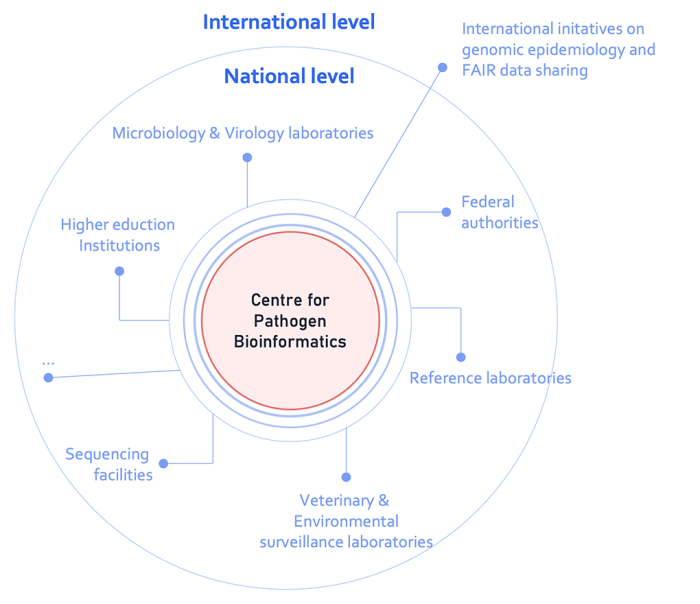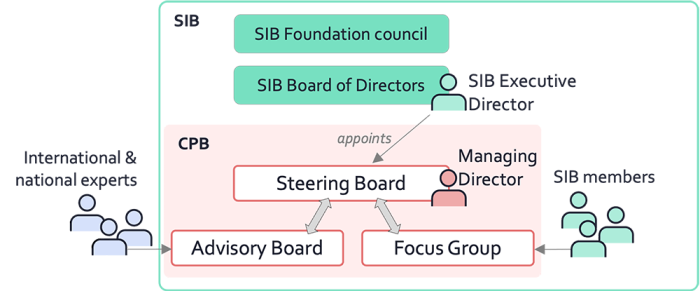The Centre for Pathogen Bioinformatics offers expertise and services in pathogen data management and analysis, computational molecular epidemiology, and related multi-site project management. Core data analysis platforms and dashboards which played major roles during the COVID-19 pandemic response contribute to the mission of the Centre. They facilitate the coherent interpretation of relevant data to be prepared for future pathogenic threats. At the interface between public health and research, the Centre ensures that Switzerland remains at the forefront of data management and data analysis required for real-time surveillance, generating insights for evidence-based global pathogen response and public health strategies.
Missions
- The Centre for Pathogen Bioinformatics (referred to as CPB) offers expertise and services in pathogen bioinformatics, computational molecular epidemiology and related multi-site project management to Swiss Federal Authorities and within any Swiss pandemic preparedness and molecular surveillance program.
- The CPB ensures that Switzerland remains at the forefront of data management and data analysis required for real-time surveillance.
- The CPB generates insights for evidence-based global pathogen response and public health strategies.

The Centre provides expertise, resources and services in pathogen bioinformatics in surveillance and pandemic preparedness and response initiatives.
What is pathogen bioinformatics?
Pathogen bioinformatics is a field that combines principles and tools from bioinformatics to study and analyze pathogens—organisms that cause disease in their hosts, such as viruses, bacteria, fungi, and parasites.
This interdisciplinary field utilizes computational methods to understand the genetic and molecular mechanisms of pathogens, with the aim of improving disease diagnosis, treatment, prevention and outbreak monitoring.
Pathogen bioinformatics plays a crucial role in modern infectious disease research, offering insights that are essential for developing preventive and contingency measures by public authorities.
The CPB strengthens SIB’s mission to generate knowledge and provide means for better health worldwide.
Activities
Based on existing and new resources from SIB’s national network, the Centre develops the following range of activities to support its many direct stakeholders and the entire research community in the field including notably:
What is pathogen bioinformatics?
Pathogen bioinformatics is a field that combines principles and tools from bioinformatics to study and analyze pathogens—organisms that cause disease in their hosts, such as viruses, bacteria, fungi, and parasites.
This interdisciplinary field utilizes computational methods to understand the genetic and molecular mechanisms of pathogens, with the aim of improving disease diagnosis, treatment, prevention and outbreak monitoring.
Pathogen bioinformatics plays a crucial role in modern infectious disease research, offering insights that are essential for developing preventive and contingency measures by public authorities.
The CPB strengthens SIB’s mission to generate knowledge and provide means for better health worldwide.
Data hosting, management, processing, and sharing
The Centre offers services for data generators and data analysers:
- Central hosting and management of Swiss molecular data for pathogens of public health interest.
- Provision of routine bioinformatics and digital automation support for reference laboratories, public health authorities and research laboratories.
- Acting as data broker to international data repositories.
- Coverage of a large range of sample types isolated from patients, food, animals and the environment.
The Centre develops open-source software based on the latest state of research:
- Data sharing infrastructure facilitating global exchange of FAIR pathogen data.
- Data processing pipelines which include quality control, curation as well as standard and specialized methods (typing, assembly, phylogenetics) supporting reproducible data analysis and open science principles.
Data analyses, interpretation & expert consultancy
- Collaboration with resources developed by SIB Groups in the field of pathogen bioinformatics and computational molecular epidemiology.
- Development of standardized descriptive statistical analyses and implementation of integrative dashboards and reports for public health authorities (e.g. pathogen data reports for the infectious disease dashboard of the Federal Office of Public Health), researchers and citizens in Switzerland and beyond.
- Provision of specialized analyses to support public health authorities.
- Development of new resources where gaps are identified.
International collaboration and alignment
- Active/leading role in international efforts for FAIR pathogen data access and sharing, including the development of a global Pathogen Data Network.
- Alignment and collaboration with international initiatives and infrastructures (e.g. ELIXIR Pathogen Data Focus Group, Global Microbial Identifier, Public Health Alliance for Genomic Epidemiology (PHA4GE), WHO International Pathogen Surveillance Network,...).
Resources
Data analysis platforms and their bioinformatics tools are core in enabling reproducible analysis of large and complex data sets. They also provide essential real-time surveillance information based on the combination of national with international data.
Below is the current list of resources developed or co-developed within SIB groups that contribute directly to the mission of the Centre. We are committed to developing these strategic resources further in a sustainable, coordinated, and synergistic way, and in alignment with international initiatives to strengthen Switzerland’s role at the forefront of molecular surveillance and digital transformation.
Note: please refer to the individual resources’ website to learn more about their features, as well as specific governance bodies and funding sources.

The Swiss Pathogen Surveillance Platform SPSP – a secure One-health online platform that enables near real-time sharing under controlled access of pathogen sequencing data and their associated clinical/epidemiological metadata. SPSP informs the FOPH's infectious disease dashboard and is a consortium whose members are listed here.

Nextclade - curation and annotation of datasets (Neher group, University of Basel & SIB, together with the group of Trevor Bedford)

Nextstrain - key surveillance tool during but also before the pandemic notably for Influenza where it supports yearly vaccine development (Neher group, University of Basel & SIB, together with the group of Trevor Bedford)

covSPECTRUM- SARS-CoV-2 dashboard for interactive querying of mutations and variants; it became a core tool for pango lineage designation proposals(Stadler group, ETHZ & SIB)

CoVariants - reference for the overview of variants and mutations (Hodcroft group, Swiss-TPH & SIB)

V-pipe - estimation of viral genomic diversity in clinical and environmental samples, including detection and quantification of genomic pathogen variants in wastewater and estimation of their relative fitness advantages (Beerenwinkel group, ETHZ & SIB)

Loculus - software package to power microbial genomic databases and Pathoplexus - open-source database supported by Loculus to enhance the sharing and analysis of human viral pathogen genomic data (Hodcroft, Neher & Stadler groups, STPH, UniBas, ETHZ & SIB)
Projects
We list below some projects that are funded under the umbrella of the Centre.
FAIRification of pathogen bioinformatics resources under the Centre for Pathogen Bioinformatics. This project will strengthen this ecosystem of resources through increased interoperability and by providing an integrated system for analysis and sharing of pathogen genomic data, thereby fostering genomic epidemiology globally. July 2024 – June 2025. Funded by Swissuniversities B3.2 ORD Funding Scheme. PIs: Tanja Stadler, Niko Beerenwinkel, Richard Neher. Partners: Emma Hodcroft, Aitana Neves.
Pathogen Data Network. The Pathogen Data Network is a global consortium aiming to provide infrastructure, tools, training, outreach and support to FAIR infectious-diseases data sharing and reuse. It will cover diverse biodata types, including host and pathogen genomics, transcriptomics, proteins, pathways and networks, imaging and cohorts. It involves 12 institutions and 19 partners from around the world (Sept. 2024 – June 2028). Funded by NIH-NIAID BRC program. Main PI: Aitana Neves.
Organization
Steering Board:

Niko Beerenwinkel (Computational Biology)

Emma Hodcroft (EVE Epidemiology and Virus Evolution)

Richard Neher (Microbial Evolution)

Tanja Stadler (Computational Evolution)

Selected press coverage
Read the press release in German and French about the inauguration of the Centre in Bern, on 23 January 2025.
The launch of the Centre for Pathogen Bioinformatics was widely covered in the Swiss press, including:
- RTS – multimedia interviews with the Centre’s Managing Director, Aitana Neves, and SIB Executive Director Christophe Dessimoz (French)
- Le Temps – interview with Aitana Neves (French)
- 24 heures – interview with Aitana Neves and Christophe Dessimoz (French)
- La Liberté – interview with Aitana Neves (French)
- Tages Anzeiger – interview with Aitana Neves (German)
- Radio SRF 1 / Echo der Zeit – interview with Aitana Neves and Christophe Dessimoz (German)








